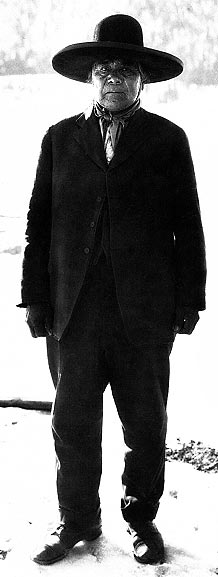
Tuskegee Syphilis Experiment
|
Tuskegee Syphilis
Experiment
see
also Forced
Inoculations
from
http://www.acponline.org/journals/annals/15aug97/currnazi.htm
Steps Still Being Taken To Undo Damage of "America's
Nuremberg"
Annals of Internal Medicine 15 August 1997.
Howard Wolinsky
The voluntary consent of the human subject is absolutely essential.
—The Nuremberg Code
The year 1947 was a watershed for medical ethics and medical care. Fifty
years ago, the Nuremberg Code, created in response to the atrocities of Nazi
medicine, called for the informed consent of participants in human research.
That same year, penicillin was recognized as the standard of care for syphilis.
Researchers from the U.S. Public Health Service failed to connect these two
milestones. They continued to conduct a long-running study in Tuskegee, Alabama,
on the course of syphilis in untreated African-American men and chose not
to provide penicillin to study participants. Today, some researchers attribute
problems in recruiting African Americans for clinical trials, at least in
part, to the Tuskegee study.
On 19 August 1947, the Tribunal for the Doctors' Trial, conducted in the
Palace of Justice in Nuremberg in the American Occupation Zone of Germany,
concluded that 23 Nazi medical doctors had committed atrocities in their
conduct of concentration camp experiments involving Jews, Russians, and others.
Seven of the defendants were executed for war crimes and crimes against humanity.
The judgment at Nuremberg, conducted under the auspices of the U.S. military,
contains a 10-point statement on medical ethics, called the Nuremberg Code.
Among other things, the code called for patient consent in experiments and
avoidance of the physical and mental suffering of participants.
At the same time, nearly 5000 miles away in impoverished Macon County, Alabama,
399 African-American men with untreated syphilis were being studied to determine
the natural history of the venereal disease. The study began in 1932, years
before the adoption of the Nuremberg Code. The fact that therapy was withheld
from the men was not made public until a journalist exposed the experiment
in 1972. In fact, James Jones, PhD, a University of Houston historian and
author of Bad Blood: The Tuskegee Syphilis Experiment (Free Press, 1993),
wrote that as awareness of the benefits of penicillin grew, the researchers
saw greater urgency in continuing "a never-again-to-be-repeated opportunity."
When interviewed by Jones, John Heller, MD, then director of the Public Health
Service's Division of Venereal Diseases, said he saw no connection between
the Nazi atrocities and the Tuskegee study. "For the most part, doctors and
civil servants simply did their jobs. Some merely 'followed orders,' others
worked for 'the glory of science,'" Jones explained.
Wake-up Call
Arthur Caplan, PhD, director of the medical ethics program at the University
of Pennsylvania in Philadelphia, described the Tuskegee study as "America's
Nuremberg."
Caplan, author of When Medicine Went Mad: Bioethics and the Holocaust (Humana
Press, 1992), said: "Tuskegee was really the experiment that set American
medicine on its ear. I think Americans had this belief that they couldn't
or wouldn't do the kind of evil things that the Germans did. Tuskegee was
a gigantic wake-up call."
The outrage over the Tuskegee study led to the requirement of informed consent
and to other safeguards, such as the creation of institutional review boards,
data and safety-monitoring boards, and continuing ethics education for
researchers.
Louis Sullivan, MD, president of Morehouse University School of Medicine
in Atlanta and former secretary of the Department of Health and Human Services
(HHS), explained that the Tuskegee study, more than any other factor, resulted
in the African-American community's distrust of the medical establishment.
And, he added, its impact is not limited to the poor or the uneducated. "To
me, one of the striking things here is that even among educated African
Americans, there is a level of suspicion and mistrust."
Many researchers agree with Sullivan's assessment, although the impact of
the Tuskegee incident on the nonparticipation of African Americans in clinical
trials has not been quantified. Sullivan, who is a hematologist said that
the result goes beyond a difficulty in recruiting African Americans to
participate in clinical trials. "It is also more difficult to get African
Americans to donate blood or to sign up as potential organ donors."
Transplant surgeon Clive Callender, MD, chairman of the Department of Surgery
at Howard University College of Medicine in Washington, D.C, recalled a small
opinion survey that he conducted in 1978. The survey showed that the third
most important obstacle to organ donation by African Americans was the Tuskegee
incident. The only barriers that weighed more heavily were lack of knowledge
about transplantation and religious beliefs.
The eventual turnaround in organ donations by African Americans is one of
the great success stories in the effort to overcome the aftermath of the
Tuskegee study. The rate of organ donation among African Americans in 1982
was only 8 per million. By 1996, the rate had reached 26 per million, close
to the rate for the white population.
Callender said that the change was accomplished by asking African Americans
who had undergone transplantations and those awaiting transplantations to
accompany African-American health professionals to educate potential donors.
"We take it in any forum that will allow us, if it's one-on-one, if it's
a health fair, a group discussion, a church, school, barbershop, beauty parlor,"
said Callender, who is testing the same approach in Latino, Asian-American,
and Native American communities. "Taking that kind of team with us helps
overcome the distrust. Then, the Tuskegee incident becomes less and less
of a problem."
Researchers report mixed success in recruiting African Americans for clinical
studies. Funmi Olopade, MD, director of the Cancer Risk Clinic at the University
of Chicago Medical Center, explained that "there is a reluctance among African
Americans to participate in research. There has been a long distrust of the
medical community in the African-American community. Part of this is based
on this assumption that nobody really cares about them. They are very suspicious
about participating in research. It is very difficult for them to consent."
Olopade said she has been able to convince African-American women to participate
in her studies on the genetics of breast cancer, but there have been instances
in which she has been unable to meet recruitment goals. "It is really appalling
that in all of the studies that are coming out from so many different centers,
we have one, maybe two African Americans who have participated," she complained.
In contrast, Duane Bonds, MD, leader of the sickle-cell disease scientific
research group at the National Heart, Lung, and Blood Institute, said she
had no difficulty attracting 299 African-Americans with sickle-cell disease
for a study using hydroxyurea as therapy. "The sickle gene was first described
in 1910, and yet we don't have any effective therapies until hydroxyurea,"
which was approved for use about 85 years later. "So the patients have been
very anxious to help us answer good clinical questions. They were really
willing to enter into a double-blind, placebo-controlled trial," she explained.
Other researchers have been able to increase African-American participation
in research by using African-American health professionals for outreach programs
and by offering incentives, such as free medical care and reimbursement of
travel expenses. Ironically, the Tuskegee researchers used the same strategies
to recruit their subjects.
Recent Steps
On the 50th anniversary of the Doctor's Trial in Nuremberg and the 25th
anniversary of the end of the Tuskegee study, researchers, the public, and
the U.S. government are still coping with the damage caused by the Tuskegee
study. To promote healing, President Clinton offered a formal apology on
16 May 1997.
Sullivan, who was HHS secretary under President Bush, stated: "The President's
apology will help the healing process. I think it was necessary to begin
the process of rebuilding trust for [Tuskegee participants] who are still
alive and for their families, and really for the town of Tuskegee itself
and for the larger African-American community."
George Annas, JD, director of the Law, Ethics, and Medicine Program at Boston
University and co-author of The Nazi Doctors and the Nuremberg Code: Human
Rights in Human Experimentation (Oxford University Press, 1992), said that
Clinton missed the mark instructing HHS Secretary Donna Shalala to encourage
more African Americans to participate in research. The larger problems are
racism and the inadequacy of health care provided to African Americans, according
to Annas. If anything, he said, the government's top priority should be
recruiting more African Americans as medical students rather than as medical
research participants.
But the apology served as a reminder to members of the research establishment
who once seemed oblivious to the significance of the Nuremberg Code. Not
only did the Tuskegee study continue after the Nuremberg Doctors' Trial,
but other questionable research was launched in the postwar United States,
including studies on humans involving chemical warfare, radiation, and lysergic
acid.
Caplan noted, "Americans basically thought that the German doctors were crazy,
or lunatics, or third-raters. One way to cope with the involvement of medicine
in Nazi crimes was basically to demonize and peripheralize them." It took
the Tuskegee incident for the U.S. medical community to learn the lessons
of the Nuremberg Trials and to create more safeguards for research participants,
he added. Bonds contended that today's protections make a difference. She
is convinced that if data and safety-monitoring boards were in place during
the Tuskegee study, the research would have been halted and participants
would have been given effective therapy.
Annas is hopeful: ":Just now, 50 years after Nuremberg, we might have a chance
to start taking [the code] seriously as a medical ethics document and not
just as a legal document."
See also: Nuremberg
Code of Ethics (Human Experimentation)
MORE READING
Miss
Evers Boys (Video with Alfre Woodard and Lawrence Fishburne)
Bad
Blood: The Tuskegee Syphilis Experiment by James H. Jones
Tuskegee
Syphilis Study by Fred Gray
The
Black-White Test Score Gap by Jencks and Phillips
Being
Black, Living in the Red: Race, Wealth and Social Policy in America
by Dalton Conley
Kinship:
A Family's Journey in Africa and America by Philippe E. Wamba
National Public
Radio's "Talk of the Nation" Discussion of the Tuskegee Studies
Kevin C. Pyle's
Original Work: Pink Medicine (Site currently
inoperative)
Families Emerge
as Silent Victims
US Government's Plutonium Experiments on Citizens
[From News From the Libertarian Party, November 21, 1996]
WASHINGTON, DC -- Jail time, not payoffs -- that's the way to deal with 30
years of secret, gruesome government medical experiments, the Libertarian
Party said today.
"The government should not be able to buy its way out of responsibility by
paying off victims with taxpayers' money," said Steve Dasbach, chairman of
America's third-largest political party. "Instead, attempted murder charges
should be filed against the politicians who approved secret radioactivity,
chemical, and biological experiments on innocent Americans."
Dasbach's comments came after Energy Secretary Hazel O'Leary announced this
week that the government would pay $4.8 million to the families of 12 human
"guinea pigs" who were injected with plutonium and uranium -- without their
knowledge or consent -- during secret government experiments in the 1940s.
"Politicians, bureaucrats, and government employees should be held to the
same standard as any other American," Dasbach said. "If an average citizen,
for example, secretly injected people with highly radioactive Plutonium 239,
he would be in jail facing murder charges. Instead, the government is spending
$4.8 million of our money to try to buy a clean conscience."
"The use of taxpayers' money for the payoff is especially reprehensible,"
said Dasbach.
"If compensation is warranted, it should be in the form of victim restitution
from the specific individuals responsible for the crimes," he said. "Taxpayers
shouldn't be further punished for the crimes of politicians."
"First, thousands of individuals were the subjects of horrific government
experiments for more than three decades," he said. "Then, Americans were
kept in the dark for another two decades while the government tried desperately
to cover up its crimes. Now, we're being taxed to pay off the victims of
these ghoulish experiments -- while the politicians and bureaucrats who committed
these crimes remain at large."
In announcing the settlement, O'Leary said the government was "grateful"
to the victims for "the tough lessons they have taught us about trust,
responsibility, and accountability between the government and the people."
"The real lesson this case teaches is: Government can't be trusted," countered
Dasbach. "If politicians have power over our lives, they will abuse it. And
the more power we give politicians, the more they abuse it. If nothing else,
this tragic case should end the myth that such atrocities can't happen in
America."
Despite the $4.8 million payoff, lawsuits continue to pile up from as many
as 20,000 other individuals who are demanding compensation by the government
for biochemical experiments conducted in the 1940s, '50s, and '60s, according
to news reports.
But that's just the tip of the iceberg, noted Dasbach.
A Congressional subcommittee hearing in Washington, DC on September 28, 1994
revealed that up to 500,000 Americans were endangered by secret defense-related
tests between 1940 and 1974 -- including covert experiments with radioactive
materials, mustard gas, LSD, and biological agents. For example, between
1949 and 1969, the Army released radioactive compounds in 239 cities to study
the effects, according to General Accounting Office testimony the hearings.
Other secret tests were conducted on prisoners, terminally ill patients,
military personnel, hospital patients -- even children. At the time of the
hearings, GAO officials stressed that the number of victims might increase,
as new information was uncovered from Pentagon, CIA, NASA, and Energy Department
files.
The Committee had its origins when public controversy developed surrounding
human radiation experiments that were conducted half a century ago. In November
1993, the Albuquerque Tribune published a series of articles that,
for the first time, publicly revealed the names of Americans who had been
injected with plutonium, the man-made material that was a key ingredient
of the atom bomb. Reporter Eileen Welsome put a human face to what had previously
been anonymous data published in official reports and technical journals.
"As World War II was ending," she wrote, "Doctors in the United States injected
a number of hospitalized patients with plutonium, very likely without their
knowledge or consent. The injections were part of a group of experiments
to determine how plutonium courses through the human body. The experiments,
and the very existence of plutonium, were shrouded in secrecy."
On reading the articles, Secretary of Energy Hazel O'Leary expressed shock,
first to her staff, and then in response to a question posed at a press
conference. She was particularly concerned because the Department of Energy
had its earliest origins in the agencies responsible for building the atomic
bomb and sponsoring the plutonium experiments. During the Cold War, these
agencies had continued to do much of their work in the twilight zone between
openness and secrecy. Now, the Cold War was over. The time had come, Secretary
O'Leary determined, to make public anything that remained to be told about
the plutonium experiments.
Subsequent press reports soon noted that the plutonium injections were not
the only human radiation experiments that had been conducted during the war
and the decades that followed. In Massachusetts, the press reported that
members of the "science club" at the Fernald School for the Retarded had
been fed oatmeal containing minute amounts of radioactive material. In Ohio,
news articles revived an old controversy about University of Cincinnati
researchers who had been funded by the Defense Department to gather data
on the effects of "total-body irradiation" on cancer patients. In the Northwest,
the papers retold the story of Atomic Energy Commission funding of researchers
to irradiate the testicles of inmates in Oregon and Washington prisons in
order to gain knowledge for use in government programs. The virtually forgotten
1986 report prepared by a subcommittee headed by U.S. Representative Edward
Markey, "American Nuclear Guinea Pigs: Three Decades of Radiation Experiments
on U.S. Citizens," was also recalled to public attention.
Coincidentally, the fact that the environment had also been used as a secret
laboratory became a subject of controversy. A November 1993 congressional
report uncovered 13 cases in which government agencies had intentionally
released radiation into the environment without notifying the affected
populations. At various times, tests were conducted in Tennessee, Utah, New
Mexico, and Washington State.
Senator John Glenn understood the importance of national security, but he
found it "inconceivable... that, even at the height of the communist threat,
some of our scientists and doctors and military and perhaps political leaders
approved some of these experiments to be conducted on an unknowing and unwitting
public."
Were all the human radiation experiments done in secret? Are any secret or
controversial studies still ongoing?
Scientists and science journalists pointed out that some of the highly publicized
experiments had long ago been the subject of technical journal articles,
even press accounts, and were old news; other commentators countered that,
for most of the public, articles in technical journals might as well be secret.
How, why, and from what population groups were subjects selected for experiments?
Some suspected that subjects were disproportionately chosen from the most
vulnerable populations -- children, hospitalized patients, the retarded,
the poor -- those too powerless to resist the government and its researchers.
How many intentional releases took place, and how many people were unknowingly
put at risk? The answer here was sketchy; the releases identified in the
November 1993 Glenn report had all been performed in secret, and much information
about them was still secret.
What did our government and the medical researchers it sponsored do to ensure
that the subjects were informed of what would be done to them and that they
were given meaningful opportunities to consent? Today, federal government
rules require the prior review of proposed experiments, to ensure that the
risks and potential benefits have been considered and that subjects will
be adequately informed and given the opportunity to consent. But the standards
of today, many historians and scholars of medical ethics noted, are not those
of yesterday. Others, however, declared that it was self-evident that no
one should be experimented upon without his or her voluntary consent.
Panel Releases
Report on Human Radiation Experiments (1995)

|

























